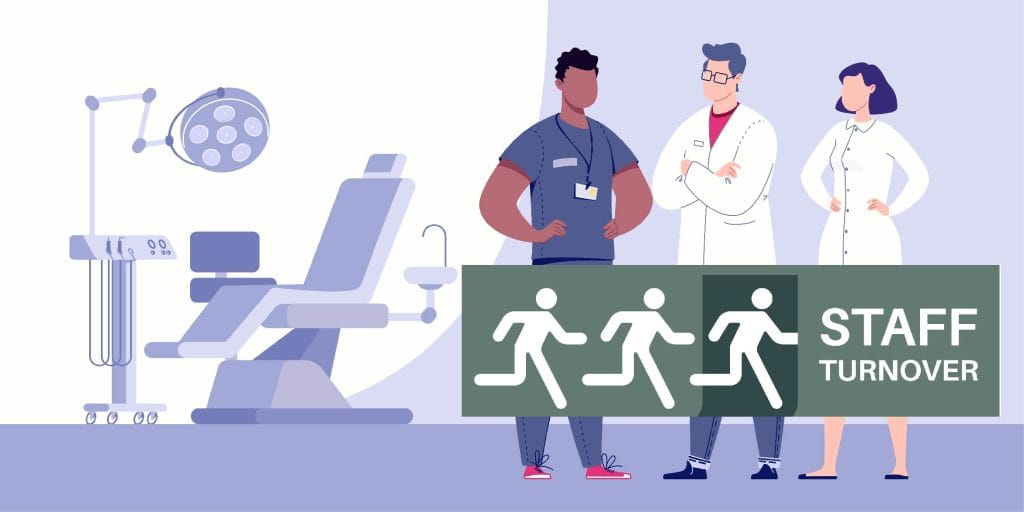Last updated on May 23rd, 2024 at 12:57 pm

Have you been thinking about making the switch from PPO to Fee-for-Service (FFS)? Or at the very least, reducing your dependence on some of your lower-reimbursing insurance plans?
If so, you’re not alone!
We’ve advocated for this shift for over 20 years, but lately, the message has gained a lot more urgency. Why? Because the dental landscape is changing and there are some real dangers associated with staying in-network moving forward.
Whereas going fee-for-service used to be a good idea, recent economic changes have made it a necessity.
(Related: It’s Time to Get Out-of-Network… NOW!)
What Does “Fee-for-Service” Really Mean?
Let’s clear up some misconceptions first. Fee-for-service doesn’t mean you are rejecting insurance outright. It simply means you receive your full, regular fee for services provided.
For example, under a PPO, a crown might bring in $880, but with FFS, you’d get the full $1,300. And yes, you can still accept assignment where it makes sense. If a patient comes from a PPO background and chooses to stay with you after you drop their plan, they pay their out-of-pocket portion front, and you can still accept their insurance’s out-of-network benefits.
Or, if you really want to fully divest from insurances, you can choose not to accept assignment, meaning the patient will pay the full cost of treatment and then personally submit for reimbursement on their own.
Either way, it’s straightforward and lets you keep more of what you earn.
Why Go Out-of-Network?
Look at the numbers! It’s all about the financials.
Imagine you’re producing $160,000 in services but only collecting $100,000 because of PPO write-offs. You still incur all the costs of $160,000 production. 
Your lab and supply company don’t give you a “PPO discount.” Your staff doesn’t ask for 40% less pay when you’re treating PPO patients.
Carrying 100% of the costs for 60% of the income simply is not very sustainable. In years past, you may have been able to make it work, but now you’re going to get squeezed.
What’s Changed Recently? The Economic Argument for FFS
Since the start of 2020, we’ve seen inflation rates soar. Everything costs more—supplies, staff wages, you name it.
Under PPO constraints, you can’t raise your fees to match these rising costs; you’re stuck with what the insurance decides. As a business owner, not being able to control your own prices is a massive liability.
these rising costs; you’re stuck with what the insurance decides. As a business owner, not being able to control your own prices is a massive liability.
This is exacerbated because some insurance plans have been lowering reimbursements. That’s right, at a time when costs are soaring, they’re paying you less!
The Big Fear: Will Patients Leave?
This is the scariest part for most dentists. “All my patients will leave. I’ll go broke!”
No, you won’t!
Now, don’t go dropping insurances suddenly without a strategy in place. So long as you plan ahead a bit, you don’t need to worry.
Let’s break it down.
Data shows that the average patient loss from dropping PPOs is around 30%.
Say you have patients A, B, and C. They all need crowns, for which your normal fee is $1,300. The PPO fee is $800.
If you did all the patients’ crowns at PPO rates, you’d receive $2,400.
But now let’s say you decide to go out of network. Patient C doesn’t stay without insurance, so you lose that patient, leaving you with patients A and B. This rate is actually 33%, but for the sake of example let’s keep going.
You do the crowns on patients A and B at $1,300 a crown, totaling $2,600.
So, you could have done the crowns for all three patients under PPO for $2,400, or just the two for $2,600.
You would make more income after losing a third of your patients! The profit margin is far higher, too, when you factor in what you save on material costs, labor costs, lab fees, etc.
And if the idea of treating fewer patients doesn’t sound good to you, you can always attract more new patients by spending a bit on marketing (much less than the 40% you were previously losing in write-offs).
Projecting the Numbers for Your Practice
Want to see exactly how the numbers would shake out for your practice?
Making the Switch: Your Roadmap to FFS
How do you make the switch? Every practice is different, some of you might have a small percentage of PPO patients, and others might be deeply embedded.
There are a few steps to sorting it out and creating a plan going forward.
When a client of ours wants to go out-of-network, we do a “Roadmap to a Fee-for-Service Practice” consultation with them. Here are the broad strokes of what we do:
By the way—for a limited time we’re offering this consultation to ANY dentist that is considering going out-of-network. Book your complimentary Roadmap to a FFS Practice here.
- What is your end goal? Do you want to drop one or two of your least desirable insurance plans, or are you looking to completely transform your practice to 100% fee-for-service?
- Evaluate how deeply entrenched you are in insurance plans and how quickly you want to get out. If half of your patients are already FFS and you just have a few PPO plans, that’s a quick transition. On the other hand, if you’re majority HMOs, PPOs, union plans, etc, then you’ll want to do a more gradual process while building up your FFS patient base.
- Crunch the numbers on each individual insurance plan. Here we find out what each plan pays, how much is being written off, and how many patients does it account for. Some plans might have such low reimbursements that you’re actively losing money on them and could just drop them immediately with no liability. Conversely, a premier plan might pay close enough to your full fee that it’s worth keeping.
- Create a sequence and timeline. Based on the info from step 3, we’ll prioritize which plans to drop first and create a timeline, typically between 3-9 months for PPOs but longer for a heavily HMO practice.
- Review your internal processes and marketing. Some fine-tuning may be advised for your patient flow, case acceptance, recall program, and new patient acquisition.
- Renegotiate if applicable. If some plans are going to be dropped 6-12+ months in the future, then you may want to contact them to see if they’ll raise your fee schedule in the meantime. It’s usually not worth paying a renegotiation company to do it for you if you’re planning on dropping it anyways, but there’s no harm in the doctor calling the insurance company themself to try.
- Hammer out the details. Lastly, you’ll need to look through your contracts, draft any letters you’ll need to send to patients/insurance companies, and get your staff on the same page about how this will go and the right way to explain it to patients.
Those are the key steps! This is something you can do on your own, but it’s much easier to do this planning with an expert who has lots of experience. Get a personalized plan to ensure a smooth transition without sacrificing patient care or practice profitability.

Take Control of Your Practice
Switching to fee-for-service is about taking control of your financial future. Yes, it’s a big step, and it’s normal to feel apprehensive. But remember, the goal is to enhance your profitability and enjoy the practice of dentistry on your terms.
Think about it—no more dealing with frustrating fee schedules or insurance limitations. Just you, your patients, and the quality care you provide. Isn’t that why you got into this profession in the first place?
Let’s make your practice everything you’ve dreamed it could be. Consider this your invitation to rethink how you do business. You might just find it’s the best decision you’ll ever make for your practice.




No Comments
Be the first to start a conversation